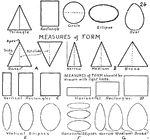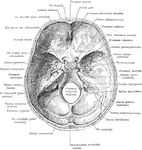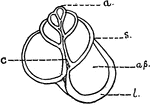
Helix Shell
"Helix. A, an empty shell in section from apex to base...a, apex of shell; ap., aperture of shell; c,…

Stipule
"Stipulae.--Two small leaves, placed usually at the base of the floral leaf, and on opposite sides of…

Onion Leaf
"Longitudinal section of an onion leaf. sca, thickened base of leaf, forming a bulb-scale; s, thin sheath…

Leaf Bases
"A, Shapes of bases of leaves; B, Peltate leaf of Tropaeolum. 1, heart-shaped; 2, arrow-shaped; 3, halberd-shaped."…

Grass Inflorescence
"Diagram of inflorescence of a grass. g, sterile glumes; P1, a flowering glume; P2, a scaly bract (palea);…
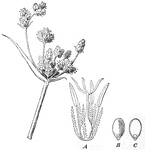
Sedge
"Inflorescence, flower, and seed, of a sedge. (Great Bulrush, Scirpus lacustris.) A, magnified flower,…
Cubing
A visual representation of cubing. "In the diagrams, Figure 1 represents 40 cubed and has a content…

Cylinder Parts
"Explanation of the cylinder. a, altitude; c, circumference of base, or perimeter; d, diameter; s, lateral…
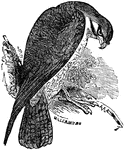
The Falcon
"The Falcon is a famous bird of prey. It is characterized by a bill curved from the base."
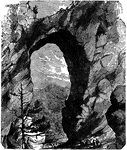
Natural Bridge in Virginia
" In Rockbridge County, Virginia, is to be found one of the greatest curiosities in the United States,…

Conic Section Showing A Circle
An illustration showing the intersection of a plane and a cone. The cone is intersected by a plane parallel…
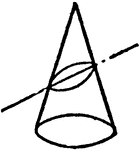
Conic Section Showing An Ellipse
An illustration showing the intersection of a plane and a cone. The cone is intersected by a plane neither…

Construction Of A Parallelogram
An illustration showing the construction used to erect a parallelogram given two sides and an angle.…
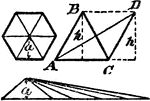
Area Of Regular Polygon Proof
An illustration showing that the area of a regular polygon is equal to the area of a triangle whose…
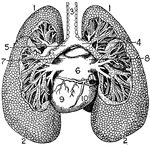
Lungs
"The Lungs. 1, Summit of lungs. 2, Base of lungs. 3, Trachea. 4, Right bronchus. 5, Left bronchus. 6,…

Construction Of A Cycloid
An illustration showing how to construct a cycloid. "The circumference C=3.14D. Divide the rolling circle…
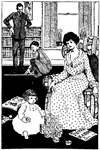
Homework
A boy doing math homework with help from his father and a meter stick. His mother helps his younger…
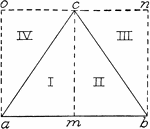
Area of Triangle
"The triangle ABC is divided into 2 right triangles I and II. ABC is seen to be equal to 1/2 of the…
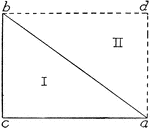
Area of Triangle
"The child sees triangle ACB = triangle ADB, and that I + II = CA - DB; and so he sees that the area…

Area of Triangle
"Fig. 3 shows triangle I = triangle II, III = IV, and so triangle ABC = 1/2 of rectangle ABDE. The fact…

Area of Parallelogram
"From Figure 4 he sees a parallelogram equal to a rectangle of the same base and altitude. Cut out and…

Area of Trapezoid
"The student sees the trapezoid is equal in area to a rectangle whose base is the average base of the…

Area of Trapezoid
"The student sees the trapezoid is equal in area to a rectangle whose base is the average base of the…
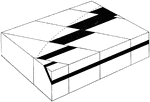
Outcrop Diagram
"Diagram to illustrate crescentic offsetting of outcrops due to progressively increasing tilting of…
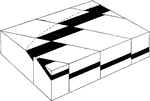
Outcrop Diagram
"Diagram to illustrate crescentic offsetting of outcrops due to progressively increasing throw of orgaraphic…
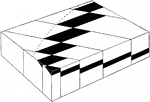
Outcrop Diagram
"Diagram to illustrate crescentic offsetting of outcrops due to progressive decrease in width of orographic…
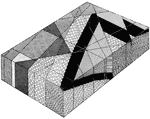
Basalt Diagram
"Diagram to illustrate the inferred structure in the vicinity of the "Triangle." Arkose conglomerate…
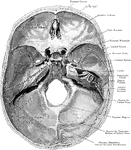
Base of the Skull
The base of the skull viewed from above. Three Fossae are recognized -the Anterior, Middle, and Posterior…

A Side View of the Cartilages of the Larynx
A side view of the cartilages of the larynx. Labels: *, The front side of the thyroid cartilage. 1,…
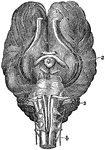
Base of Brain of a Horse
The base of brain of a horse. Labels: l, Cerebrum. 2, Ganglion of sight. 3, Cerebellum. 4, Medulla Oblongata…
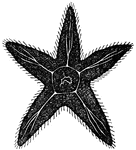
Diagram of a Radiata
In the Radiata, the starfish manifests one of the simplest forms of nervous systems. it consists of…

Orographic Blocks
"Unit orographic blocks in granite, near the knife works, Hotchkissville. a Area over downthrown block."…
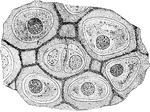
Hyaline Cartilage Cells
The matrix of hyaline cartilage has a dimly granular appearance like that of ground glass, and in man…
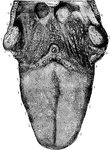
Tongue
The papillar surface of the tongue, with the fauces and tonsils. Labels: 1, circumvallate papillae,…

Fungiform Papillae
The fungiform papillae are scattered chiefly over the sides and tip, and sparingly over the middle of…
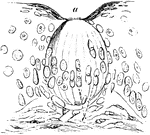
Taste Goblet from Dog's Epiglottis
Taste goblet from dog's epiglottis (laryngeal surface near the base) , precisely similar in structure…
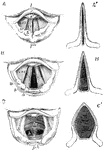
Movement of the Vocal Cords
Three laryngoscopic view of the superior aperture of the larynx and surrounding parts. Labels: A, the…

Upper Part of the Larynx
View of the upper part of the larynx as seen by means of the laryngoscope during the utterance of a…
Cortical Gray Matter of the Cerebrum
The five layers of the cortical gray matter of the cerebrum. 1, Superficial layer with abundance of…

Gothic Lectern
The Gothic lectern of the 15th century had a base made out of wood and the slope was made out of wrought-iron.…
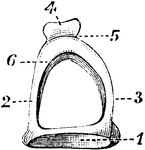
Stapes on Stirrup-Bone
The stapes on stirrup-bone. 1, base; 2 and 3, arch; 4, head of bone, which articulates with orbicular…

Corti from the Dog
Vertical section of the organ of Corti from the dog. Labels: 1 to 2, homogeneous layer of the so-called…

Sustentacular Fibers of the Retina Fiber Basket
Diagram showing the sustentacular fibers of the retina fiber basket above the external lumbar membrane;…
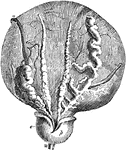
Bladder and Prostate Gland
Dissection of the base of the bladder and prostate gland, showing the vesiculae seminales and vasa deferentia.…

Potato Root Stages
"Regeneration at the leaf-base of potato leaves (Solanum tuberosum). a, roots formed; b, tuber-like…
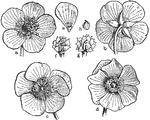
Buttercup Flowers
"Flower of a buttercup (Ranunculus sp.); a, b, normal, showing 5 petals; c, d, petalody of stamens;…
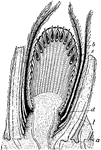
Cycadeoid
"Cycadeoidea Wielandi. Longitudinal section through the axis of a female inflorescence, or cone. l,…
Neck-Covert
"From the head, backward to the tail, the body feathers increase in strength and size, also alter in…

Tail-Covert
"From the head, backward to the tail, the body feathers increase in strength and size, also alter in…
Helix
A cylindrical helix is a curve generated by a point moving uniformly around a cylinder and uniformly…
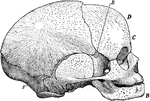
Side View of Fetal Skull
Side view of a fetal skull. The coronal suture extends from the top of the head downwards on either…

Rosebud vase
"Make the little vases of large punk rosebuds; those begining to unfold are the best. Peel off the outside…
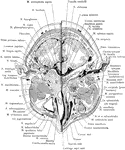
Cross Section of Head Exposing Maxillary Sinus
Section of the head immediately below the orbits, at the level of Reid's base line exposing the maxillary…




